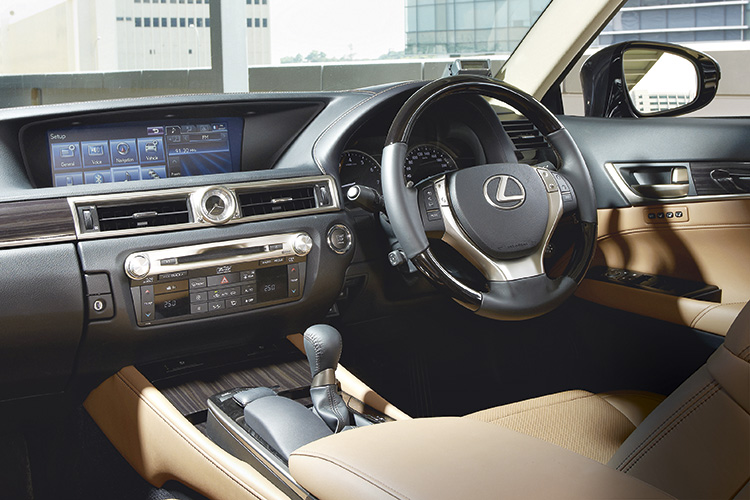
The Lexus GS250 is a handsome and well-built Japanese executive saloon.
There is one feature inside the all-new Lexus GS saloon that this motoring journo can claim credit for (sort of) – the classy analogue clock at the centre of the dashboard.
You see, I asked every Lexus chief engineer I ever met in Singapore in the past four years why the company continued to put a cheap digital time display in all its cars, including the flagship LS. I even badgered the Lexus guys about this overseas – in December 2008 at the international debut of the RX in California, and in October 2010 at the global launch of the CT200h in Paris.

Lexus GS250 driving environment is extremely relaxing, very user-friendly and made to the higher Japanese quality standards; you could drive all day in there.
My incessant questioning no doubt compelled Lexus to specify a proper clock at long last, starting with the latest GS. It’s not quite the Grand Seiko I was hoping for, but it’s definitely much grander than the old “Casio” read-out.
The whole cockpit is grand, in fact. The leather is delectable and everywhere (including on the dash top), the dark wood decor is tip-top and the satin metal trim is cool (and not just to the touch). The plastics, although not exactly expensive, feel sturdy and their finish does not vary from one area to another. All the switches are tight and most of them have a softly damped action. Interior lighting (except for the sunvisor mirrors) uses LEDs, giving it a sophisticated glow. About the only ungrand bit is the shift-unlock button on the transmission panel, but who uses that anyway?

Every knob is top-notch, but Remote Touch “mouse” takes practice to master.
The transmission proper is much more likely to be used often, so its contact points for the driver have undergone Lexus’ proverbial pursuit of perfection. The gear knob is comfortably cupped in the palm of my hand, like a “Nippon pro baseball”, and the way it moves through the P-R-N-D-M gate is as smooth as a professional baseball player making his pitch. Tapping the paddle shifters is a pleasure, too, thanks to their metallic material and solid “short-throw” action.
The 6-speeder slips into every gear as skilfully as a master chef slicing sashimi, and it is always the correct ratio for the driving situation as advised by my right foot on the throttle pedal. There is no need to override the well-programmed automatic, but if you do, its responses to your “+/–” commands are decidedly relaxed.

Even in the sportiest of its four drive modes, the GS250 still possesses a certain Zen in the way it rides and handles.
The same calm applies to the 2.5-litre V6 – at least until 4000rpm, where its induction note turns throaty and stays that way as the tacho needle continues climbing towards the 6600rpm redline. The car’s so-called intake sound generator obviously works, making the GS250 rumble differently from the IS250 that shares the same engine codenamed 4GR-FSE. Despite being bigger and some 60kg heavier, the GS250 clocks a similar century sprint time as the IS250 – 8.6 seconds versus 8.4 seconds, an academic difference at best.
The larger Lexus also feels nearly as nimble as its sporty IS sibling, yet rides like a true Tokyo limo worthy of Yakuza bigwigs. Imperfect tarmac and terrible traffic are quietly dismissed by the GS, which isolates its occupants very well from the outside whirl, using layer upon layer of hidden tatami (or maybe just excellent insulation).

Two passengers of average height will travel int he lap of Lexus luxury here; a third traveller will feel less pampered.
Yakuza chauffeurs will also appreciate the car’s stable handling and easy steering, although the latter might be too Playstation-soft for the keen driver who still has all his fingertips. Switching the drive mode to Sport S+ will add more weight to the wheel, but since it doesn’t provide better feedback at the same time, said driver will probably just make the most of the sharper throttle response, peakier gearchanges and stiffer damping (test car’s Luxury spec includes Adaptive Variable Suspension). The red “spotlight” over the instrument meters when in Sport S+ mode provides further encouragement to drive quickly.
And the person at the wheel of the GS250 can drive for long distances without fatigue. There are multiple electric adjustments for the driver’s seat (down to varying the bolsters beside the torso), supportive “butterfly” headrests and air-conditioned cushions. The cabin’s climate control is extremely effective, readily replicating cool spring or cold winter at the touch of a button – in our scorching Singapore summer.

Same 2.5-litre V6 as the Lexus IS250 and similar acceleration, too, but GS250 sounds enjoyably different above 4000rpm.
As the driver sits and chills, both literally and figuratively, he will also enjoy clear visibility through the windscreen and windows, even the one behind – it used to be a “Lexus letterbox” in the previous GS but not any longer, and there is now a rear view camera, too.

The Lexus GS250 badge.
After my test drive of the Lexus GS250, I feel like an honoured guest who has just left an upmarket ryokan after a weekend break – refreshed, well-fed and satisfied that all the yen has been well-spent.
On your guest drive of the new Lexus, remember to check out its classy analogue clock, because it was my “idea”.

The Lexus GS250 looks good from any angle, really.
Lexus GS250 2.5 (A)
ENGINE 2500cc, 24-valves, V6
MAX POWER 209hp at 6400rpm
MAX TORQUE 253Nm at 4800rpm
GEARBOX 6-speed automatic with manual select
0-100KM/H 8.6 seconds
TOP SPEED 225km/h
CONSUMPTION 10.8km/L (combined)
Check out the successor to the GS250, the Lexus GS300












